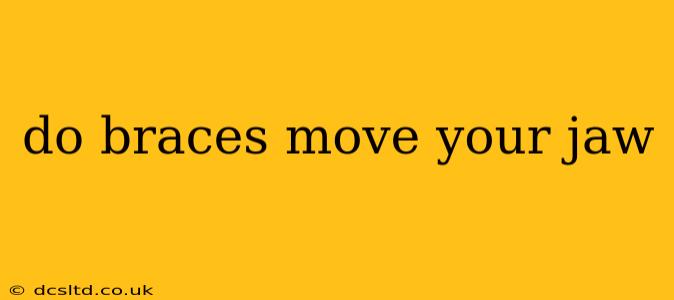Many people wonder if braces can actually move their jaw. The short answer is: it depends. While braces primarily focus on straightening teeth, certain orthodontic treatments can influence jaw position, but not in the same way many might assume. Let's delve into the nuances.
How Braces Work: Primarily on Teeth, Not Directly on Jawbones
Braces work by applying gentle, consistent pressure to individual teeth. This pressure gradually moves the teeth into their desired positions by stimulating the bone remodeling process. The bone around the roots of the teeth reshapes itself, allowing the teeth to shift. This process is remarkably precise and controlled, thanks to the careful planning and execution of an orthodontist.
When Braces Might Influence Jaw Position
While not their primary function, braces can indirectly influence jaw position in several specific situations:
1. Correcting Overbites and Underbites:
Severe overbites (where the upper teeth significantly overlap the lower teeth) or underbites (where the lower teeth protrude in front of the upper teeth) often involve misalignment of the jaw itself. In these cases, orthodontic treatment might employ techniques that subtly influence jaw growth or position. This is typically done in conjunction with other treatments like jaw surgery in more severe cases. Braces alone are unlikely to significantly alter jaw position in these instances; they are often a part of a broader treatment plan.
2. Early Treatment in Growing Children:
Orthodontic intervention in younger children (often with removable appliances) can sometimes guide jaw growth and development. By addressing issues early, an orthodontist can help encourage proper jaw alignment and prevent more significant problems later on. This is more about guiding growth than directly moving a fully formed jaw.
3. Functional Appliances:
Some specialized appliances used in orthodontics, such as functional appliances, are designed to influence jaw growth and relationships. These are not strictly "braces" in the traditional sense but are used to address skeletal discrepancies. These appliances often work in tandem with braces later in treatment.
What Braces Definitely Don't Do: Major Jaw Reshaping
It's crucial to understand that braces cannot dramatically reshape or reposition a fully developed jawbone. That requires more invasive procedures, such as orthognathic surgery. Orthognathic surgery is a surgical procedure performed by an oral and maxillofacial surgeon to correct major jaw misalignments. This is a very different approach than orthodontic treatment with braces.
What About Jaw Pain with Braces?
Many patients experience some discomfort and jaw soreness initially when they get braces. This is normal as the teeth begin to move. However, persistent or severe jaw pain should be reported to your orthodontist. It's important to differentiate between the normal discomfort of orthodontic treatment and potential problems that require attention.
Can Braces Fix a Misaligned Jaw?
While braces won't fix a severely misaligned jaw, they often play a vital role in treating the consequences of jaw misalignment. For example, if you have an underbite, braces can help correct the teeth's position relative to the jaw, even if the underlying jaw issue isn't directly addressed by the braces themselves. In some cases, braces are an essential part of a multi-step treatment plan to address more complex jaw issues.
This information is for general understanding only and should not replace professional advice. Consult with your orthodontist or a qualified dental professional for accurate assessment and personalized treatment planning regarding your specific situation.
